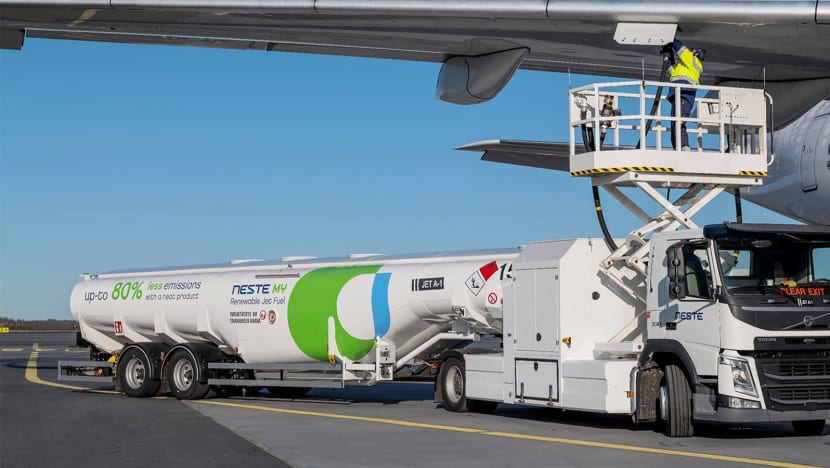CNA Explains: What is sustainable aviation fuel and will it change how we fly?
Why is it so expensive, and what are governments like Singapore doing in this space?

Finnish energy giant Neste is the largest producer of sustainable aviation fuel (SAF) in the world. (Photo: Neste)

This audio is generated by an AI tool.
SINGAPORE: At this week’s Singapore Airshow – Asia’s biggest aerospace event – “sustainable aviation fuel” (SAF) has reigned as a top buzzword.
As the sector races to meet net-zero emission goals by 2050, SAF has been touted as a leading decarbonisation solution.
But this green alternative comes with a heavy price tag, part of which will soon be shouldered by travellers in the form of costlier flight tickets.
Singapore, for instance, on Monday (Feb 19) became the first country to impose a sustainable fuel levy.
What's sustainable aviation fuel?
SAF is jet fuel made from organic or waste-derived material known as feedstock, instead of petroleum.
It can be produced from a number of sources, including:
- Pure biofuels – from crops such as sugarcane, corn grain, palm oil and soybean
- Waste-based fuels – from sustainable biomass such as forestry residues, municipal waste like recycled cooking oil and agricultural waste
- Synthetic e-fuels – from captured carbon emissions that are combined with hydrogen
What are its advantages?
SAF can power commercial planes with all the properties of traditional jet fuel. It's chemically similar, so it can be integrated into existing plane engines and airport infrastructure.
The big difference is its smaller carbon footprint. SAF can reduce emissions by up to 80 per cent, compared to its fossil-based counterpart.
Hence it's an immediate and scalable solution to decarbonising the industry, unlike other options such as hydrogen or electric power, which require an overhaul of jet engines and refuelling systems.
“The beautiful thing about SAF is that it's ready to go today,” said aviation journalist Matt Driskill. “We don't have to change anything ... SAF is the way to go because it is something that can really make a difference now.”
Currently, SAF is blended with normal jet fuel at up to 50 per cent for usage, with the industry working towards 100 per cent in future.
For instance, manufacturing giant Boeing is building all its new jets to be fully SAF-compatible by 2030.
SAF could contribute around 65 per cent of the reduction in emissions needed by the sector to meet its 2050 net-zero goals, according to estimates by the International Air Transport Association (IATA).
But this needs production to be greatly ramped up to around 450 billion litres per year.
What's holding it back from wider, quicker adoption?
Currently, global supply of SAF – at about 600 million litres last year – barely meets 1 per cent of the aviation industry’s total fuel requirements.
Global production is still increasing – last year’s total SAF produced was double that of 2022, and this year’s is expected to triple 2023’s amount.
Market leader Neste is investing heavily to push its global production capacity to around 2.75 billion litres annually by 2030, from just 125 million litres last year.
The Finnish energy giant’s refinery in Singapore – the largest SAF production facility in the world – has an annual capacity of about 1.26 billion litres.
Generating the required quantities of SAF would need huge areas of land and natural resources. Already, there are growing environmental concerns about change of land use and deforestation as demand for SAF grows.
Due to its limited supply, SAF can cost three to five times more than ordinary jet fuel.
With fuel already one of the biggest costs for airlines, any SAF mandates by governments could affect those on shaky financial ground, especially smaller firms.
Airline trade body IATA said sustainable fuel is likely to stay more expensive than kerosene even when large-scale production kicks in, due to the low availability of sustainable feedstocks and the continuing development of new production technologies.
The cost will likely trickle down to consumers as airlines point to wafer-thin profit margins.
What are governments doing about SAF?
From 2026, all flights departing from Singapore will be required to use at least 1 per cent SAF, with an aim of increasing it to 3 to 5 per cent by 2030.
With the levy, it will translate into an additional US$2 for an economy short-haul flight between Singapore and Bangkok, and US$12 for a long-haul flight between Singapore and London.
Elsewhere, several global airlines plan to substitute some amounts of their fuel usage with the greener alternative.
Britain and Japan are targeting low-carbon fuels to represent 10 per cent of jet fuel demand by 2030.
The European Union has regulated that the minimum share of SAF available at EU airports will rise from 2 per cent in 2025 to 70 per cent in 2050.
And the United States has set a goal to supply enough SAF to meet 100 per cent of aviation fuel demand, also by 2050.
Can SAF truly take off?
Industry players say airlines need credits and incentives to help bring down the price of sustainable fuel.
“If airlines aren't buying SAF, then producers aren’t going to produce it. Governments need to mandate or encourage it by giving subsidies to fuel companies or airlines to offset the costs,” said Mr Driskill, who is the editor of Asian Aviation.
Neste’s vice president of renewable aviation in Asia Pacific Sami Jauhiainen called for long-term regulatory policy frameworks on SAF.
“Getting sufficient certainty of demand for sustainable aviation fuel is important in order to unlock the investments to scale up the production capacity for sustainable aviation,” he said. “(At the same time) enable the airlines a competitive market to use SAF without being in a disadvantaged position against competitors who might not be using the sustainable fuel.”
With more players in the market and as production of SAF matures, its price is expected to then become less costly.
“It's the policy element that's really going to drive and accelerate the uptake of SAF,” said Boeing's APAC regional sustainability lead Robert Boyd. “Prices will come down. There is significant progress in the amount of volume being developed. It may seem small relative to where we need to get to but (compared to) two or three years ago, (it’s) a giant leap.”
While other green measures also need to be in place on the runway to 2050, Neste's Jauhiainen said sustainable fuel is still the most viable solution for the foreseeable future.
“We also need more fuel-efficient aircraft, better air traffic management and even electric- or hydrogen-powered planes could play a role,” he said.
“But a large share of aircraft will likely remain dependent on liquid fuels. Hence, the role of sustainable aviation fuels is so large for aviation's climate goals.”

















